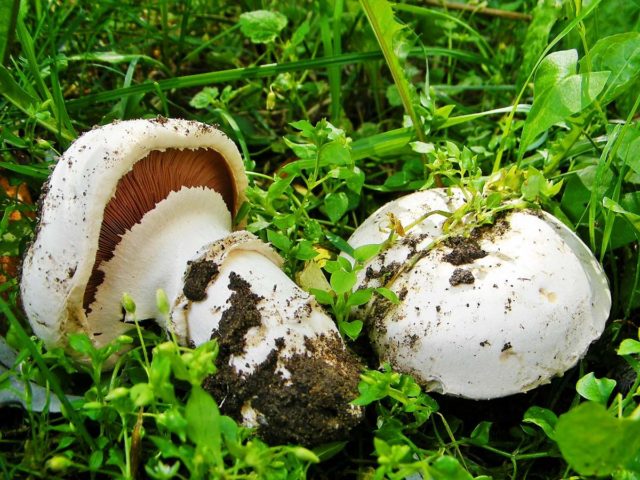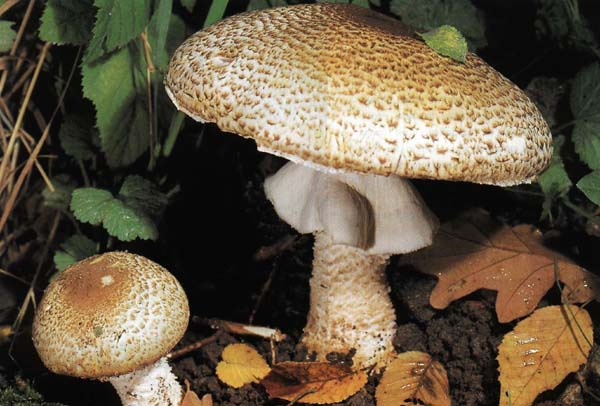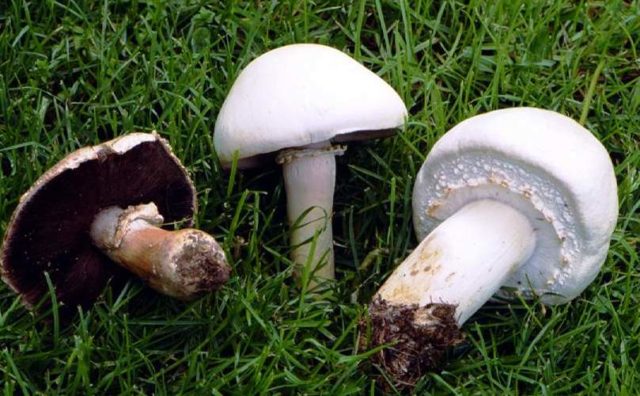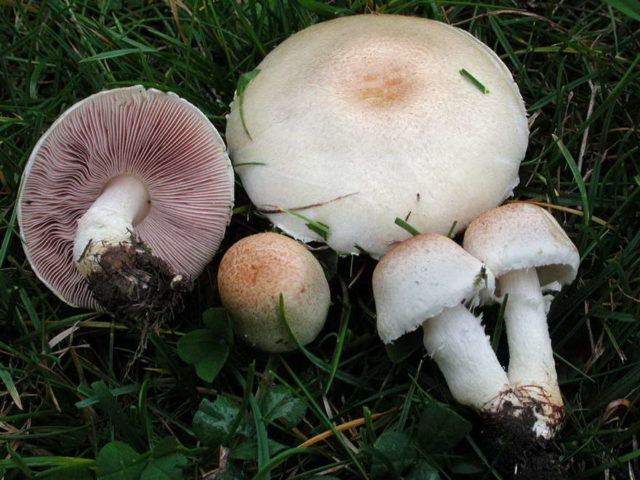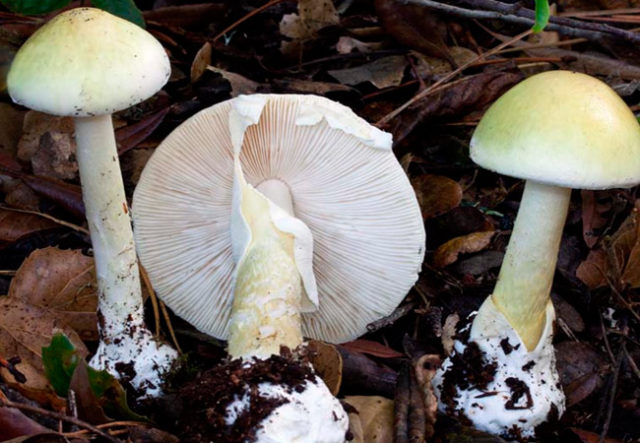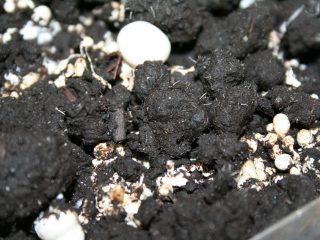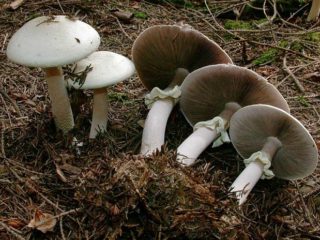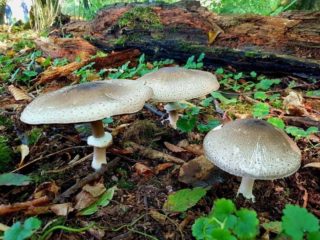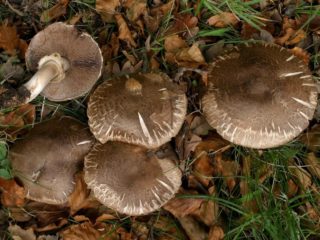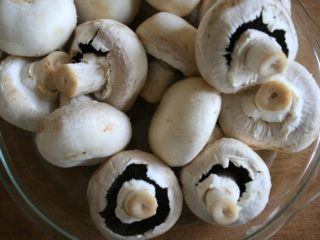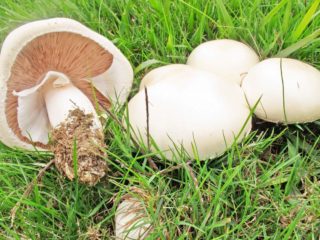Content
Double-ringed champignon (lat. Agaricus bitorquis) is an edible mushroom of the Champignon family (Agaricaceae), which, if desired, can be grown on your own plot. Other names for this species: four-spore champignon or sidewalk champignon. The latter reflects one of the places where the fungus is most widespread - within the city it often grows near roads.
What does a double-ringed champignon look like?
The cap of a ripe fruiting body can reach 4-15 cm in diameter. It is painted white, sometimes slightly grayish, as is the leg.To the touch, the cap of the double-ringed champignon is completely smooth, although sometimes in the very center you can feel barely noticeable scales.
At the first stage of development, the cap is egg-shaped, but then it takes on a half-open appearance. In mature mushrooms, it resembles a hemisphere flattened on top, the edges of which bend inward.
The hymenophore of a mature two-ringed champignon consists of narrow light pink plates, which turn brown in old mushrooms. In young specimens it is beige, almost white. The plates are arranged quite freely. At the initial stage of growth, the hymenophore is covered with a dense film.
The leg of the double-ringed champignon is quite massive - it grows only 3-4 cm in height, while its diameter is almost the same - 2-4 cm. Closer to the cap you can find a torn ring of two layers - these are the remains of the protective film that covered plates of the fruiting body.
The flesh of this species is dense and fleshy. It is white in color, however, at the cut site it quickly turns pinkish.
Where does the champignon grow?
The distribution area of the double-ringed champignon is extremely wide - it is almost cosmopolitan. This means that mushrooms are found on almost all continents, in different climatic zones. Most often, their small accumulations can be found on soil that is rich in organic matter - in forests (both coniferous and deciduous) and parks. Mycelium can form on dead trees, old stumps and anthills. Within the city limits, double-ringed champignon often grows along roads and fences.
This species bears fruit for a long time - from late May to September. It rarely grows alone, but the groups of fruiting bodies are quite scattered and not dense.Finding the harvest is complicated by the fact that they have a short stalk, so the mushrooms are often covered with leaves, grass and soil.
Is it possible to eat double-ringed champignon?
Double-ringed champignon is an edible mushroom with excellent taste. It tolerates any type of heat treatment well and serves as a key ingredient for a wide variety of dishes: salads, hot and cold appetizers, julienne, etc.
One of the main positive qualities of this species is its high productivity - double-ringed champignon can be grown in large quantities in the garden.
False doubles
Very often, the two-ringed champignon is confused with the August champignon (lat. Agaricus augustus). The main difference between these two species is the color of the cap - in the August subspecies it is darker. Despite the fact that the surface of its cap itself is white, it is covered with many light brown plates. Such scales are also present on the legs of fruiting bodies. Otherwise the mushrooms are very similar.
This is an edible species, however, its taste can hardly be called excellent.
Large-spored champignon (lat. Agaricus macrosporus) is an edible mushroom with a pleasant taste of the pulp. Mature fruiting bodies are difficult to confuse with double-ringed champignons, as these are real giants. The diameter of the cap of this species is on average 25 cm. The main difference between young specimens is a longer stem and a pleasant almond smell.
Elegant champignon (lat. Agaricus comtulus) is a rather rare species with excellent taste. It is edible and tolerates any type of cooking.
This variety is distinguished from double-ringed champignons by the color of the cap - it is grayish-yellow, often with pink streaks. Otherwise, these mushrooms are almost identical.
The most dangerous counterpart of the double-ringed champignon is the deadly poisonous toadstool (lat. Amanita phalloides). It should not be eaten as food, as the pulp of the toadstool causes severe poisoning, even death.
These mushrooms are distinguished by the plates of the hymenophore - in the two-ringed champignon it is either pinkish (in young specimens) or brown (in old mushrooms). The hymenophore of the pale grebe is always white.
Rules for collection and use
Double-ringed champignons are collected before the first frost. It is recommended to adhere to the following rules:
- Double-ringed champignon is best harvested at the stage of development when a thin film is stretched tightly between the edge of the cap and the stem. It is also permissible to collect older mushrooms in which it has already torn and the pink plates of the hymenophore have become visible. Overripe specimens, which are distinguished by brown, darkened plates, should not be collected - eating their pulp can cause food poisoning.
- The fruiting body must not be pulled out of the ground. It is carefully cut off with a knife just above the ground or twisted out of the mycelium. This way she will be able to bear a harvest next year.
- It is recommended to sprinkle the place from which the mushrooms were taken with a thin layer of covering soil.
- It is better to go for mushrooms early in the morning, when the air is still quite humid and cool. This way the harvested crop will remain fresh longer.
Fresh champignons can be safely eaten even raw, without subjecting them to heat treatment. The main thing is to properly wash each fruiting body and remove the skin from them. To make soil and other debris easier to remove from the crop, it can be soaked briefly in a container of water. Caps cut into thin slices are added raw to cold appetizers and salads.
Also, double-ringed champignon can be fried, stewed, boiled and baked. After such processing, the harvested crop is added to a variety of sauces, pates, baked goods, vegetable stews and juliennes.
Conclusion
Double-ringed champignon is an edible lamellar mushroom with a pleasant taste that can be eaten both raw and after heat treatment. You can find it almost everywhere, however, when harvesting you should be extremely careful - young specimens can easily be confused with the deadly poisonous pale toadstools. Before you go looking for mushrooms, you need to carefully study the external differences of this species so as not to collect false doubles instead.
You can learn more about how to collect champignons from the video below:
